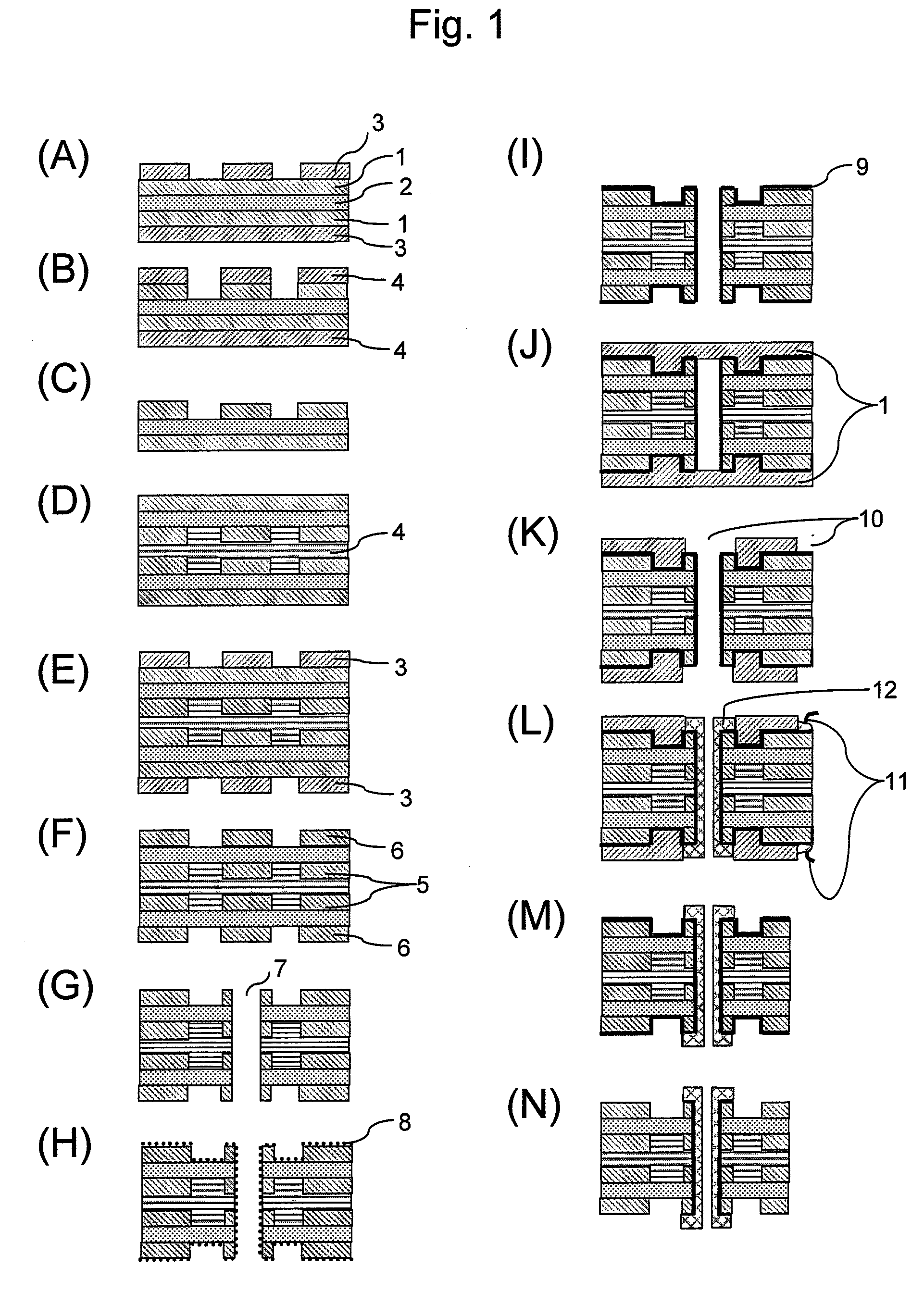Phase-Separation-Controlled Polybutadiene Resin Composition and Printed Wiring Board Using the Resin Composition
a technology of phase separation and resin composition, which is applied in the direction of synthetic resin layered products, tyre parts, woven fabrics, etc., can solve the problems of poor tack-free properties of polybutadiene resin composition, poor preservation and handling ability of prepreg, etc., and achieves small dielectric loss tangent, small relative dielectric constant, and easy formation
- Summary
- Abstract
- Description
- Claims
- Application Information
AI Technical Summary
Benefits of technology
Problems solved by technology
Method used
Image
Examples
examples
[0040] The present invention is hereafter described in greater detail with reference to the following Examples and Comparative examples, although the technical scope of the present invention is not limited thereto.
(1) Material
Crosslinking Component (A):
[0041] Low-molecular-weight 1,2-polybutadiene (number average molecular weight ≈2600 to 3400, 1,2-butadiene unit content≧90 wt %, Nippon Soda Co., Ltd., B-3000)
Crosslinking Component Used in the Comparative Examples:
[0042] High-molecular-weight 1,2-polybutadiene (RB830, number average molecular weight ≈170000, 1,2-butadiene unit content ≈90 wt %, JSR)
Low Temperature Initiator (B):
[0043] Benzoyl peroxide (abbreviation: BPO) (purity ≈75 wt %, one-minute half-life temperature ≈130° C., Aldrich Chemical Company, Inc.)
High Temperature Initiator (C):
[0044] 2,5-dimethyl-2,5-di(t-butylperoxy)hexyne-3 (abbreviation: 25B), (one-minute half-life temperature ≈196° C., purity≧90%, NOF Corporation)
examples 1 and 2
[0067] The relationship between the molecular weight of a crosslinking component and the varnish viscosity is shown in table 1. The crosslinking component used in Example 1 was low-molecular-weight 1,2-polybutadiene (B3000). Thus, it showed a low viscosity of 18 cP even in a 52-wt % toluene solution. Therefore, a low-molecular-weight crosslinking component was confirmed to be formed into a varnish with good workability.
TABLE 1Varnish viscosityComparativeComparativeExample 1Example 2example 1example 2B3000100100RB830100100Low temperature4444initiator (B)High temperature5555initiator (C)Toluene900100900400Concentration wt %11521121Viscosity cP518470Insoluble
examples 3 and 4
[0069] In the cases of Examples 3 and 4, the low temperature initiator (B) was contained in amounts of 4 parts by weight and 10 parts by weight, respectively. With the increased amount of the low temperature initiator (B), phase separation and extrusion of the crosslinking component B3000 were prevented. In addition, the fluidity of the resin composition was 5% to 20%. With the increased amount of the low temperature initiator, dielectric properties did not deteriorate, and thus good results were obtained. In both examples, the temperature dependency of elastic modulus was small, and thus the glass transition temperature was not clearly observed. Also, swelling of a laminate in toluene was not observed. Thus, good solder heat resistance was obtained.
PUM
| Property | Measurement | Unit |
|---|---|---|
| Temperature | aaaaa | aaaaa |
| Temperature | aaaaa | aaaaa |
| Temperature | aaaaa | aaaaa |
Abstract
Description
Claims
Application Information
 Login to View More
Login to View More - R&D
- Intellectual Property
- Life Sciences
- Materials
- Tech Scout
- Unparalleled Data Quality
- Higher Quality Content
- 60% Fewer Hallucinations
Browse by: Latest US Patents, China's latest patents, Technical Efficacy Thesaurus, Application Domain, Technology Topic, Popular Technical Reports.
© 2025 PatSnap. All rights reserved.Legal|Privacy policy|Modern Slavery Act Transparency Statement|Sitemap|About US| Contact US: help@patsnap.com



